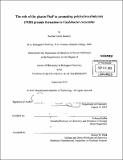| dc.contributor.advisor | JoAnne Stubbe. | en_US |
| dc.contributor.author | Buckley, Rachael Marie | en_US |
| dc.contributor.other | Massachusetts Institute of Technology. Department of Chemistry. | en_US |
| dc.date.accessioned | 2014-01-23T18:39:39Z | |
| dc.date.available | 2014-01-23T18:39:39Z | |
| dc.date.copyright | 2013 | en_US |
| dc.date.issued | 2013 | en_US |
| dc.identifier.uri | http://hdl.handle.net/1721.1/84372 | |
| dc.description | Thesis (Ph. D. in Biological Chemistry)--Massachusetts Institute of Technology, Dept. of Chemistry, 2013. | en_US |
| dc.description | Cataloged from PDF version of thesis. | en_US |
| dc.description | Includes bibliographical references. | en_US |
| dc.description.abstract | Polyhydroxybutyrate (PHB) is a biodegradable polymer produced by many microorganisms when they find themselves limited in an essential nutrient such as nitrogen or phosphorus but in the presence of an abundant carbon source. PHB and other related polymers are of interest because they have valuable properties as elastomers and thermoplastics, and are environmentally-friendly plastics than can potentially replace oil-based polymers. Bacteria package PHB as insoluble granules within the cell, maintaining the amorphous nature of the polymer, which is necessary for its degradation and reutilization when the environment becomes more conducive to growth and division. We are interested in understanding how the bacteria synthesize PHB and how they package it in such a way as to maintain its amorphous (rather than crystalline) nature. Examination of PHB biosynthesis has primarily been carried out in Ralstonia eutropha, which accumulates PHB to 80% of its cell dry weight (cdw) under the appropriate growth conditions. However most organisms do not accumulate PHB to such extremes, thus we have focused our efforts on understanding whether what we have learned about PHB biosynthesis in R. eutropha is true for organisms that accumulate far less PHB. To that end we have studied PHB accumulation in Caulobacter crescentus. Under conditions of nitrogen limitation but with abundant glucose available, C. crescentus accumulates PHB to ~12% of its cdw. We have quantitatively examined the levels of the PHB synthase, the major granuleassociated protein PhaP and PHB per cell to gain an understanding of PHB biosynthesis in C. crescentus. We have furthermore isolated and characterized the PHB synthase and PhaP, and studied their roles in polymer formation in vitro. Our results have led to a model for granule formation in C. crescentus and suggest that many aspects of the model for granule formation developed based on studies in R. eutropha are true for organisms that accumulate PHB to much lower levels. | en_US |
| dc.description.statementofresponsibility | by Rachael Marie Buckley. | en_US |
| dc.format.extent | 440 pages | en_US |
| dc.language.iso | eng | en_US |
| dc.publisher | Massachusetts Institute of Technology | en_US |
| dc.rights | M.I.T. theses are protected by
copyright. They may be viewed from this source for any purpose, but
reproduction or distribution in any format is prohibited without written
permission. See provided URL for inquiries about permission. | en_US |
| dc.rights.uri | http://dspace.mit.edu/handle/1721.1/7582 | en_US |
| dc.subject | Chemistry. | en_US |
| dc.title | The role of the phasin PhaP in promoting polyhydroxybutyrate (PHB) granule formation in Caulobacter crescentus | en_US |
| dc.type | Thesis | en_US |
| dc.description.degree | Ph.D.in Biological Chemistry | en_US |
| dc.contributor.department | Massachusetts Institute of Technology. Department of Chemistry | |
| dc.identifier.oclc | 867633351 | en_US |
